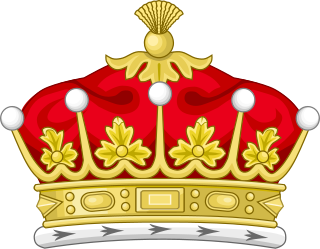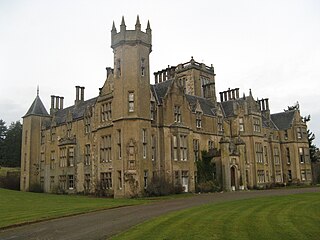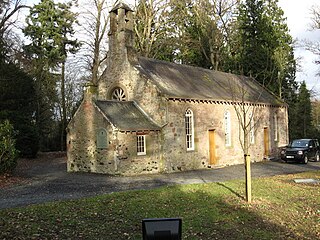
The Mormaer or Earl of Buchan was originally the provincial ruler of the medieval province of Buchan. Buchan was the first Mormaerdom in the High Medieval Kingdom of the Scots to pass into the hands of a non-Scottish family in the male line. The earldom had three lines in its history, not counting passings from female heirs to sons. Today, it is held by the Erskine family as a peerage. The current holder is Harry Erskine, 18th Earl of Buchan. Subsidiary titles are Lord Cardross and Lord Auchterhouse and Baron Erskine.

Sir Joseph Edgar Boehm, 1st Baronet, was an Austrian-born British medallist and sculptor, best known for the "Jubilee head" of Queen Victoria on coinage, and the statue of the Duke of Wellington at Hyde Park Corner. During his career Boehm maintained a large studio in London and produced a significant volume of public works and private commissions. A speciality of Boehm's was the portrait bust; there are many examples of these in the National Portrait Gallery. He was often commissioned by the Royal Family and members of the aristocracy to make sculptures for their parks and gardens. His works were many, and he exhibited 123 of them at the Royal Academy from 1862 to his death in 1890.

The National Monument of Scotland, on Calton Hill in Edinburgh, is Scotland's national memorial to the Scottish soldiers and sailors who died fighting in the Napoleonic Wars. It was intended, according to the inscription, to be "A Memorial of the Past and Incentive to the Future Heroism of the Men of Scotland".

David Stuart Erskine, 11th Earl of Buchan,, styled Lord Cardross between 1747 and 1767, was a Scottish antiquarian, founder of the Society of Antiquaries of Scotland, and patron of the arts and sciences.

Kinnaird Head is a headland projecting into the North Sea, within the town of Fraserburgh, Aberdeenshire, on the east coast of Scotland. The 16th-century Kinnaird Castle was converted in 1787 for use as the Kinnaird Head Lighthouse, the first lighthouse in Scotland to be lit by the Commissioners of Northern Lights. Kinnaird Castle and the nearby Wine Tower were described by W. Douglas Simpson as two of the nine castles of the Knuckle, referring to the rocky headland of north-east Aberdeenshire. The lighthouse is a category A listed building. and the Wine Tower. is a scheduled monument. The buildings around the base of the lighthouse are the work of Robert Stevenson.

Earlston is a civil parish and market town in the county of Berwickshire, within the Scottish Borders. It is on the River Leader in Lauderdale, Scotland.

Dryburgh is a village in the Borders region of Scotland, within the county of Berwickshire. It is most famous for the ruined Dryburgh Abbey.

Bemersyde House is a historic house in Roxburghshire, Scotland.

Craigiehall is a late-17th-century country house, which until 2015 served as the Headquarters of the British Army in Scotland. It is located close to Cramond, around 9 km (5.6 mi) west of central Edinburgh, Scotland.

Dryburgh Abbey Bridge was a cable-stayed footbridge of significant historical interest erected near Dryburgh Abbey, in the Borders of Scotland. It connected the villages of Dryburgh and St. Boswells, across the River Tweed. A crossing had existed here for centuries, originally with a ferry service.

Dryburgh Abbey Hotel is a baronial country house, located on the banks of the River Tweed, in Dryburgh about 5 km south east of Melrose in the Scottish Borders. The modern house was first constructed in 1845 and it was converted into a hotel in 1932. It is next to the ruins of Dryburgh Abbey and part of the former churchyard and its burials are within the grounds.

The Old Calton Burial Ground is a cemetery in Edinburgh, Scotland. It located at Calton Hill to the north-east of the city centre. The burial ground was opened in 1718, and is the resting place of several notable Scots, including philosopher David Hume, scientist John Playfair, rival publishers William Blackwood and Archibald Constable, and clergyman Dr Robert Candlish. It is also the site of the Political Martyrs' Monument, an obelisk erected to the memory of a number of political reformers, and Scotland's American Civil War Memorial.

Darnick is a village near Melrose in the Scottish Borders area of Scotland, in the former Roxburghshire. The name was first recorded in 1124, and has changed from Dernewic, Dernwick and Darnwick to the present Darnick. Darnick Tower was built in c. 1425, and another tower house, Fisher's Tower, is still recognisable by its remains.

Banff Castle is a ruined former royal castle near Banff, Aberdeenshire, Scotland.
Sir David Erskine was a Scottish dramatist and antiquary.

The church is named after Saint Mungo, patron saint and founder of the city of Glasgow. It belongs to the Church of Scotland Presbytery of Stirling and serves the parish of Alloa. A chapel dedicated to St Mungo is thought to have been erected during the fourteenth or fifteenth-century, which became dependent upon the Parish of Tullibody. Alloa had grown into a parish in its own right by 1600 when the Act of Assembly united the two parishes. In 1680, the original chapel was rebuilt and enlarged. The current church replaces the old parish church from the seventeenth-century which had been deemed much too small for the congregation for over seventy years and was declared ruinous and unsafe in August 1815. The condition of the old church was so bad that services were often being held in the open air rather than risking injury to the congregation The decision was finally made to abandon the old building and find a site for a new parish church. The Erskine family donated land at Bedford Place and work on the new St Mungo's church began in 1817. The church congregation temporarily worshipped in the Tabernacle until the completion in 1819 of the new church. Since land was judged at the time to have too great a value to the living to be set aside for the dead, no graveyard was planned or added to the new church. The more elaborate scale and design of the new building was intended to reflect the increased size and prosperity of the nineteenth-century congregation. The church was one of the largest in Scotland at the time it was built.

Forglen House is a mansion house that forms the centrepiece of the Forglen estate in the parish of Forglen, north-west of Turriff, Aberdeenshire, in the north-east of Scotland. The lands were given to the abbots of the Abbey of Arbroath by King William the Lion before 1211 and the Monymusk Reliquary was held there. The original castle, built around 1346, was replaced by a vernacular harled house that was later extended. Significant development of the estate began when it was acquired by the family of Lord Banff and they started the work of landscaping and planting trees. It became their main family seat during the 18th century. After the death of William Ogilvy, the eighth and final Lord Banff, the estate passed by marriage to the Abercromby baronets who continued to enhance the property and maintained it as their main residence. Sir Robert Abercromby, 5th Baronet commissioned the Aberdeen City Architect, John Smith to design the present house in 1839.

Auchterhouse Castle is a c. 13th century castle located northwest of Dundee, Angus, Scotland. The original castle was enclosed with walls, towers, and contained a keep. The castle may have been in ownership of the Ramsay family, who were hereditary Sheriffs of Angus. Sir William Wallace is alleged to have stayed at the castle and one its towers was named in his honour. King Edward I of England spent the night of the 20 July 1303 at the castle. The castle came into the possession of James Erskine, 7th Earl of Buchan who may have built the 17th century tower house.

Mertoun is a parish in the south-west of the historic county of Berwickshire in the Scottish Borders area of Scotland. Together with the parish of Maxton, Roxburghshire it forms the Maxton and Mertoun Community Council area. It was included in the former Ettrick and Lauderdale District of Borders Region, by the Local Government (Scotland) Act 1973, from 1975 to 1996.

The Kirkhill Astronomical Pillar was constructed in 1776 by David Stewart Erskine, 11th Earl of Buchan and erected in the grounds of his estate at Kirkhill House, near Broxburn, Scotland. The pillar fell into disrepair and eventually collapsed in the 1970s but fortunately the stones were preserved and the pillar was reconstructed (1988) in Almondell Country Park on land once owned by the Erskine family. The pillar records the details of an adjacent scale model of the Solar System constructed by Erskine following the measurements of the size of the Solar System deduced from the observations of the Transits of Venus in 1761 and 1769. The model, centred on a Sun of stone six feet in diameter with planets at distances and sizes to scale, has long since disappeared; only the pillar remains.



















